<< Download the FREE lead sheet here >>
“1234” by Feist has to be one of my favorite songs to sing and play on the piano.
It’s also one of my favorite songs to teach. Because while it’s really magical and beautiful…
It’s also SO simple!
There aren’t too many chords to learn, and for most of the song, your right-hand plays the same thing. That means it’s perfect for anyone who’s new to the piano and wants to play something that sounds INSTANTLY awesome and impressive.
Plus — it just makes you feel good.

The best way to learn music is by playing, not reading. Start off on a good note with our 500 Songs in 5 Days course pack. Free with your Pianote membership.
The verses all use the same chord progressions, and this is where we’ll be keeping the same pattern for our right hand even though the chords change. This can be a little confusing when you look at the lead sheet:

That can look intimidating, especially for new players. But I’ll show you exactly what shapes to play, and you’ll see how simple it is.
This is the shape you’ll be using with your right hand, and it WILL NOT change! So get comfortable 🙂

Play the top D with the pinky finger of your right hand, and let your 2nd finger (your index finger) play the A. Then you’ll use your left hand to play that bottom D.
And your left hand is the only thing that’s going to change for the whole riff.
This is called a slash chord and it can be confusing for a lot of piano players. All it means is that you play a D chord in your right hand with a C# note in the bass.
But you’re already playing a D chord with your right hand, so that doesn’t have to change. Instead, you’ll only have to step your left hand down from the D to the C#, so it will look like this:

Again your right-hand stays the same, and your left-hand steps down from C# to the B:

FUN FACT TIME!!!
A B-minor chord has the notes B-D-F#. Now you should notice there is no F# here, and there’s an A! That means this is actually a B-minor-7 chord (Bm7). The A is the 7th note of the B minor scale. I love 7th chords, and we have a full lesson on them here.
The last chord of this progression and you can probably guess what we’re going to do. That’s right, keep the right-hand the same and move only the left:

MORE FUN FACT TIME!!
A G chord has the notes G-B-D. Here you can see we have the G and the D, but no B. Instead we have an A. This is actually a Gsus2 chord! We have “suspended” the B (taken it away) and replaced it with the A (which is the 2nd note of a G scale – hence the number 2). This creates a really nice feeling of tension that needs to be resolved. You can find more on suspended chords here.
Ok, nerdy theory over. This pattern repeats for every single verse! And learning this will mean you’ve learned most of the song (yay!).
Things change a little bit when we get to the pre-chorus (or second line of the verse, however you want to think about it). Now we are going to swap out that D/C# slash chord and replace it with an Em chord:

In the video, I like to use the 1st inversion of E minor. I know inversions can be confusing, so we have a complete lesson on them here.
But remember — you’re only changing ONE chord. The rest stays the same.
There’s only one more part of this song to learn, and it’s super simple.
This chorus is really beautiful and simple to play. There are only 2 chords, and we already know one of them! That means before even looking at the chorus you can already play 50% of it.
Pretty cool, huh!
Here it is:

And you’ll play each of these chords in root position. So for the A chord you’ll play A-C#-E and for the G it’ll be G-B-D.
If you want to get fancier I show a nice little trill that I like to include (you can find it at the 3:33 mark in the video).
And that is it. The entire song repeats and uses the same chord progressions and patterns.
Make sure you watch to the end to see my cover version as well.
I hope you feel as happy learning this song as I do every time I play it.
Have fun!
Lisa Witt has been teaching piano for more than 20 years and in that time has helped hundreds of students learn to play the songs they love. Lisa received classical piano training through the Royal Conservatory of Music, but she has since embraced popular music and playing by ear in order to accompany herself and others. Learn more about Lisa.
/marketing/pianote/lead-gen/getting-started/coach.webp)
/marketing/pianote/lead-gen/getting-started/logo.webp)
By signing up you’ll also receive our ongoing free lessons and special offers. Don’t worry, we value your privacy and you can unsubscribe at any time.
We use cookies for traffic data and advertising. Cookie Policy »